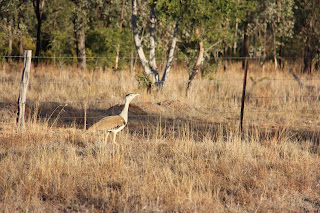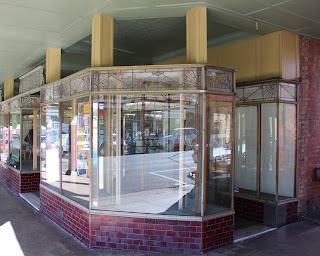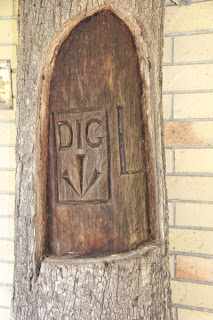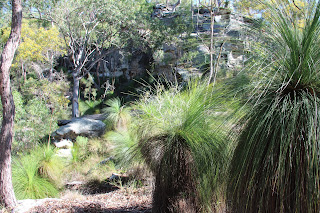Emerald’s main street is lined with massive Moreton Bay Fig trees once pruned by feral goats who were allowed to wander freely in the streets decades ago, so the trees are thick and flourishing as a result.
After a quick coffee in their shade, we headed further west where the sides of the road are becoming more and more rust red, replicated in the corroded signs the shire has made as a welcome to each town throughout the region. So very Australian.
This digging sign is for Anakie, which became the centre for gem exploration around these parts after an 1870 explorer picked up stone he thought might be ruby, but which turned out to be zircon.
In modern times, a young 14 year old boy, Smiley Nelson, was much luckier. In 1979, while specking wet rock he picked up what turned out to be the largest yellow sapphire ever found anywhere — over 13 ounces. He sold it to the Richardson brothers of Sapphire, but along with other gems on display in Sydney in 1983, it was stolen in a massive $8 million jewellery heist. Luckily it was found again, quite accidentally, three years later, and the stone rescued; only to be sold shortly afterwards to an American for a massive sum, it is said.
On to Bogantungen we drove, intent on catching up on a little family history while we were in this region as some of Pete’s family once had a cattle property there. After Anakie, the roads become narrower, the vegetation sparser; though, thankfully, the trucks and ute traffic dropped dramatically after Blackwater, and to a lesser extent, Emerald.
Only two very old men live in two very old houses in all that is left of Bogantungan. Once 28 pubs were needed to cater to the thirsty locals here, when much of the work that kept them in pocket stemmed from railway business. Today, the railway station is a dusty little building, a museum itself, as it is quite a rare example of an early Australian platform station. It houses a dusty collection of fading memorabilia and newspaper cuttings donated by locals over the years: tales of old Bogantungan.
One display tells of one of the worst train disasters in Australia’s history. Here, on a night in 1969 after heavy rains, a 12 ton tree fell and floated downstream until it crashed into a pier of the railway bridge, weakening the structure, so that when the 2am train loaded with passengers hurtled across the bridge the weight gave out. Forward propulsion was sufficient to allow the front carriages to reach safety on the opposite bank but once the bridge started to fail, the back carriages tumbled headlong into the creek, killing seven, wounding many others. Tales of heroism and great effort of that night have been proudly thumb-tacked to tired walls.
We found burial records for Pete’s family in a booklet in the museum that one of the locals had once thoughtfully compiled. We then headed out to the old property, Medway Park, where cattle still graze on grasslands: very dry now, and very isolated. Our last stop was to the old town cemetery, where we found some of the family headstones still standing, their inscriptions barely visible. Others have crumbled and been lost. We also learned that one family member is still alive, retired to Yeppoon, though a great age, so a few more leaves on the family tree have been added as a result of our visit.
Bogantungan is as far west as we travel this trip, so we turn back to Anakie and take a shortcut, past Sapphire and Rubyvale in the gem fields, heading north. These fossicking towns look a lot like a Footrot Flats version of Coober Pedy, with their assortment of shacks, crooked caravans, corrugated iron huts, and ramshackle dwellings huddled around hillocks of dug over dirt, offering every conceivable item a visiting fossicker might want: a museum; a shovel; a lesson in how to fossick; a gem to buy, a coffee to drink. So colourful and eccentric much of it made us laugh.
We followed the road from Rubyvale to Clermont which turned out to be one of those iconic Australian roads that are a joy to drive: just us, grazing beef cattle, and cattle grids rippling across the road every so many kilometres, stretching as far as the road goes, tableland grasses on all sides, mountains like tiny volcanoes set low on the horizon.
Just a few kilometres along we saw our first massive wedge-tailed eagle of this trip: deeply intent on his kill in the middle of the road. As we closed in, he had to make a giant physical effort to leave his prey, and flapped labouriously with a slow, lumbering beat of huge outstretched wings, his body barely gaining van height as we passed: so close, we could see his beautifully curved wedge tail as he retreated to safety.
As the afternoon sun set lower, kangaroos ventured out on to the quiet road, only to baulk when they saw us, ducking quickly back under the cover of shrubs, trees and grasses.
Three Australian Bustards froze along one of the perimeter fences, their colouring almost invisible against the camouflage of the speckled gum tree trunks. As we moved closer to take a photo they flapped and flew off.
Finally, we spied an elegant Eastern Great Egret fishing for its evening meal; its bill poised like a spear while standing precariously on an arched twig in one of the rare watered creek beds at the road side.
A wonderful end to a special day for Miss Bec’s birthday. Not France this year for her, which it has been for many years, but something a little closer to home.
Albeit there is a strong French connection, as Clermont, we later discovered, was named after Clermont-Ferrand in France, a place we have visited often, which turned out to be the ancestral home of Oscar de Satge, the French fellow who took up the very first run in this area, and named the place. Though, we tend to flavour the name with more of an Aussie twang than Oscar might have used.
 |
| Downtown Emerald -- dressed in green |
 |
| Anakie in rust |
.
 |
| Historic Boguntungan |
 |
| Once there was a bridge |
 |
| At rest |
 |
| Fabulous road to Clermont |
 |
| Australian bustard |
 |
| Eastern Great Egret |
 |
| Our lunch spot in Clermont the next day |







































